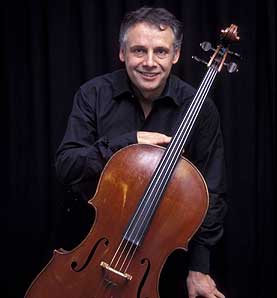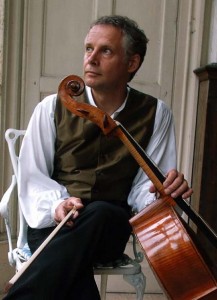Concert Review: A Spectacular Performance by Cellist Pieter Wispelwey
Dutch cellist Pieter Wispelwey first performed, as the soloist with the Australian Chamber Orchestra, in the Celebrity Series line-up back in 2007. He made his second appearance at NEC’s Jordan Hall two nights ago. It was a spectacular performance.
Pieter Wispelwey, cello, Paolo Giacometti, piano. Presented by the Celebrity Series of Boston at NEC’s Jordan Hall, Boston, MA, February 3.
By Melanie O’Neill
From the moment the concert began, Pieter Wispelwey held nothing back. Beginning with a cello arrangement of Brahms’s Sonata in G Major for Violin and Piano, the musician proffered a dynamic fluctuation between delicate and impassioned phrasing that served the lush melodies and tumultuous, emotional nature of this Romantic piece. Wisely, Wispelwey was judicious with his vibrato, not letting too much drown out or obscure the music. His light, subtle vibrato was nimbly applied where it was most effective—on melodic peaks.
Schubert’s Fantasy in C Major for Violin and Piano (arranged for cello) enabled Wispelwey to show off his virtuosity. This fantasy combines the musicality of Schubert with the flashiness of Paganini. A violinist playing the score is impressive enough, but transferring the piece to cello, where the distance between notes is at least twice as far, challenges what is physically possible. Maintaining clarity despite the acrobatics, Wispelwey wowed the audience with impressive runs, nonstop shifting, and pizzicato runs.
The pianist, Paolo Giacometti, had his work cut out for him as well with this fantasy. Because both parts are fast and extremely difficult, his ability to stay so perfectly in sync with Wispelwey was impressive. There was a downside to the pyrotechnics, however, principally because of the difficulties the dynamics pose to controlling volume. Because of the light touch necessary to facilitate such fast playing, at times the piano drowned out some of the more delicate passages in Wispelwey’s performance.
Having left the crowd with plenty to talk about during intermission, Wispelwey began the second half with the nervy decision to blend a largely atonal piece into the evening’s mix. Composed in 1955, George Crumb’s Sonata for Solo Cello exemplifies the kind of harsh, disjointed music that often dismays contemporary audiences, but Wispelway’s warm, charismatic playing, his deft control of phrasing and silence, beautifully served the composition, giving it a mysterious charm reminiscent of Ravel’s Tzigane.
The final piece of the program, Stravinsky’s Suite Italienne for Cello and Piano, pulsated with life, providing an opportunity for Wispelwey to exhibit all of his many strengths. The elegant introduction led into a melancholic Serenata, bursting with lyricism. Wispelwey’s emotive playing radiated warmth and tenderness. There was never a dull moment in the minuetto e finale. The flawless interplay between Wispelwey and Giacometti drove the music forward, bringing the concert to an exuberant close.
Wispelwey’s energy juiced up the audience. The standing ovation that followed the final notes of the Stravinsky piece brought on two encores, Faure’s heart-wrenching Après un reve and Chopin’s famous Grand Valse Brilliante Op. 18 in E flat Major. Given this kind of exhilarating performance, four years should not go by before he makes a return visit.
Tagged: Boston, Jordan Hall, Paolo Giacometti, Pieter Wispelwey, cellist, piano


